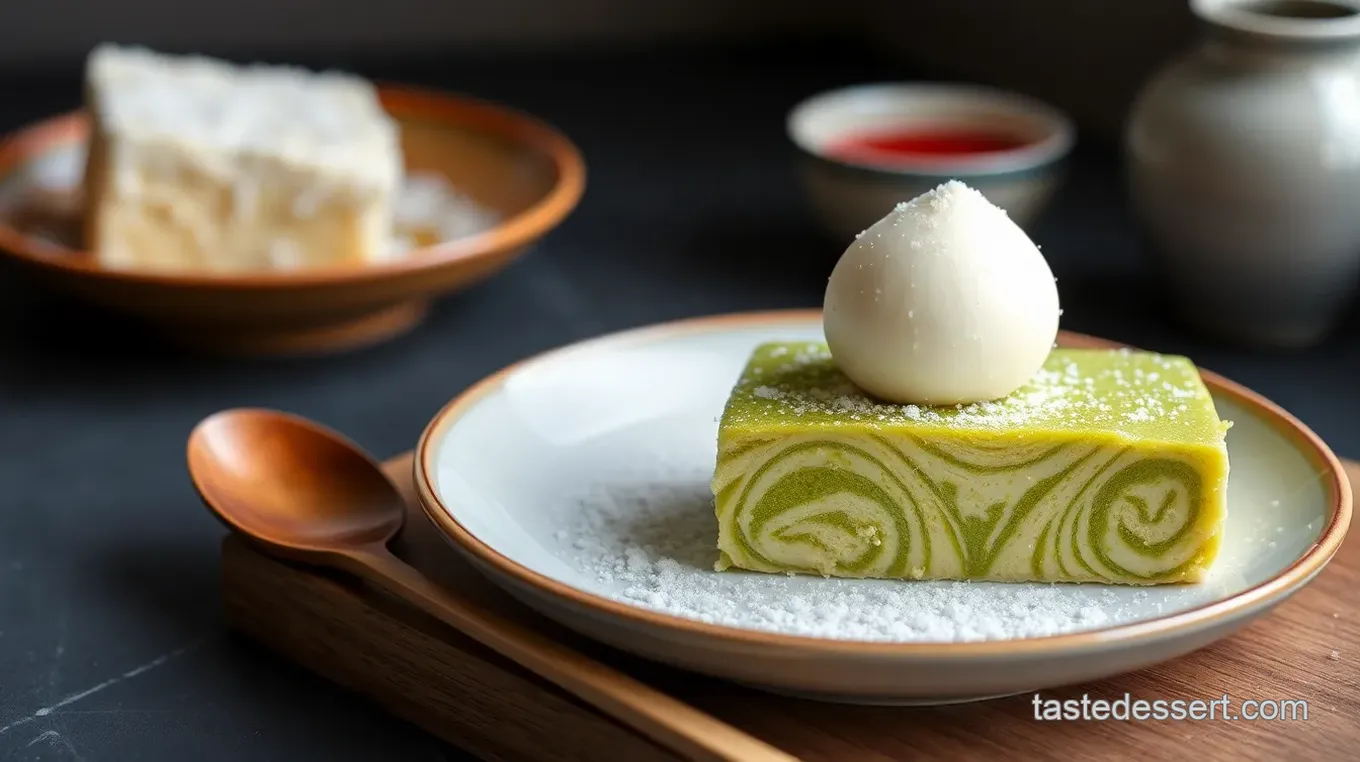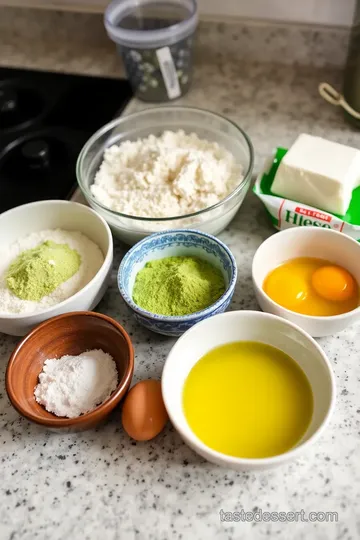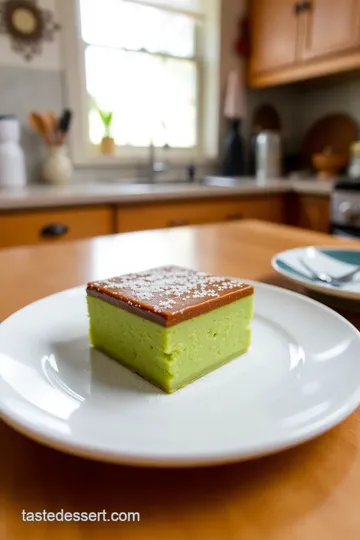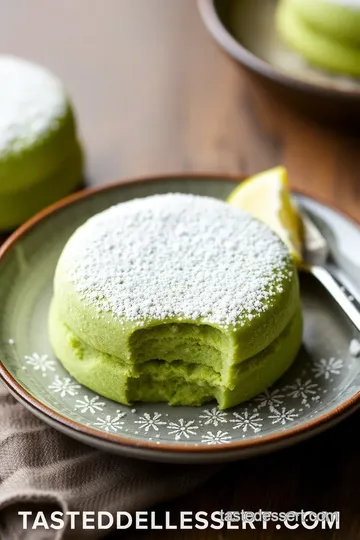Japanese Dessert Plate with Matcha Mochi, Yuzu Cheesecake, and Anko

Have you ever thought about how food can transport you to a different place and time? picture this: you're sitting in a cozy little japanese teahouse, surrounded by vibrant greenery, and the sweet fragrance of matcha fills the air.
Suddenly, a colorful plate arrives before you, displaying an array of delightful japanese sweets like matcha mochi, yuzu cheesecake, and smooth anko.
Intrigued? we're about to embark on a culinary journey that merges traditional flavors with modern twists, so grab your apron!
This japanese dessert plate is not just a feast for the eyes; it’s a blend of textures, flavors, and a sprinkle of nostalgia.
The beautiful thing about this recipe is that you can whip it up in about an hour and forty-five minutes, so it fits nicely into a weekend or an afternoon you’re ready to spend in the kitchen.
And don’t sweat it if you're not a kitchen pro; i'm calling this a medium difficulty level since i've thrown in some foolproof techniques, so even novice cooks can shine here.
The Ultimate Guide to Mastering Japanese Dessert Plates
Japanese desserts, or wagashi, are a fascinating blend of art and tradition. they reflect japan's rich cultural history and delicate approach to food.
Think about it: every bite evokes centuries of tradition, where flavors balance perfectly and every detail in presentation counts. the iconic matcha mochi originates from japan's centuries-old customs of tea ceremonies, while yuzu—a fragrant citrus known here for its bitter-sweet profile—has been cherished in japanese cooking for ages.
It’s no wonder these desserts have become beloved not only in japan but across the globe.
So what's special about this recipe? well, this dessert plate shines with unique flavor combinations. you’ve got the earthy notes of matcha from the mochi, the zesty brightness of yuzu in the cheesecake, and the comforting sweetness of anko.
Plus, i promise that the techniques you learn here will leave you with a sense of accomplishment. you’ll find them helpful not just in making these treats, but in your future cooking adventures!
What Makes This Recipe Special
Let’s talk about flavor. that luscious matcha mochi is sticky, subtly sweet, and oh-so-satisfying to bite into. the yuzu cheesecake? it’s everything you love about cheesecake, but with a floral, tangy twist that brightens your palate.
And then there’s the anko, which comes alive with the nutty richness of adzuki beans, perfectly sweetened to pair with all the other treats.
And i’ll share some of my favorite time-saving tips along the way, like how to make the most of those seemingly tedious steps.
Health and Nutrition Highlights
Now, i'm not saying you should indulge in desserts every day, but let’s chat about nutrition! this dessert plate has its perks.
Each serving brings with it a decent nutritional punch. the anko is a good source of fiber thanks to the adzuki beans, while matcha packs in antioxidants that are great for your health.
And if you're watching your dietary intake, i’ve included options along the way. you’ll discover adaptations for gluten-free and lighter versions of these desserts.
Recipe at a Glance
Before we dive into the ingredients, here's a quick summary: the total preparation time is about an hour, with an additional thirty to forty-five minutes of cooking time.
You’ll get four generous servings out of this, and it’s cost-efficient too—most of the ingredients are kitchen staples or easy to find at your local asian market.
Plus, don’t you just love the idea of serving these gorgeous creations on japanese dessert plates? it adds that authentic touch!
So, are you ready to bring a little slice of japan into your home? before we jump into getting our hands sticky with mochi-making magic and tempering flavor in the cheesecake, let’s gather our ingredients.
Trust me, once you’ve made this dessert plate, you’ll be calling yourself a whiz in asian dessert recipes!

Quality Ingredients Breakdown
Premium Core Ingredients
Let’s dive into the key ingredients for our Japanese dessert plate featuring matcha mochi, yuzu cheesecake, and anko. When it comes to premium core ingredients , quality matters!
For the Matcha Mochi:
- 1 cup glutinous rice flour (sweet rice flour) : Look for the package to say “glutinous” for that perfect chewy texture. I used the brand I found at my local Asian market, and it made such a difference!
- ½ cup granulated sugar : Be on the lookout for a fine sugar, as it dissolves more easily.
- 1 cup water : Just your regular tap water works here; no special sourcing needed!
- 2 tbsp matcha powder : Go for high-grade matcha for the best flavor—trust me, it’s worth it!
- Cornstarch (for dusting) : This helps prevent the mochi from sticking. You can go easy; just a light dusting does the job.
For the Yuzu Cheesecake:
- 8 oz cream cheese, softened : I usually just leave it out for an hour before mixing. If you forget—ahem, I’ve done that—microwave it for about 10 seconds to soften it up.
- ½ cup granulated sugar : Use the same fine sugar from before!
- 2 large eggs : Room temperature eggs will incorporate better; I usually try to remember to take them out beforehand.
- 2 tbsp yuzu juice (or lemon juice as a substitute) : If yuzu is hard to find, fresh lemon juice is a great replacement!
- 1 tsp vanilla extract : Always use pure vanilla for that warm flavor.
- ½ cup heavy cream : This adds richness to the cheesecake—guaranteed to impress.
For the Anko (Sweet Red Bean Paste):
- 1 cup adzuki beans : They can often be found dried at Asian supermarkets or in the international aisle.
- ¾ cup granulated sugar : You know the drill—fine sugar works best here too.
- Pinch of salt : Just a smidge to balance the sweetness!
- Water (for boiling) : Enough to cover the beans, so don’t skimp!
Signature Seasoning Blend
It's all about layering flavors with a lovely signature seasoning blend .
With chinese five-spice , you can mix it in with the anko too! but nothing beats a simple touch of sea salt to enhance flavors all around.
Depending on your palate, you might even try a pinch of cinnamon when making the cheesecake batter—just a thought!
Smart Substitutions
Maybe you’re missing an ingredient or have dietary preferences? No worries! Here are some smart substitutions you can make:
- Matcha Mochi : If you've got a maple syrup craving or want a little sweetness, try using maple powder instead of sugar.
- Yuzu Cheesecake : If you can’t find yuzu juice and you’re not feeling like a lemon ensoiast, try using a splash of orange juice instead! It brings a lovely zestiness too.
- Anko : If you're in a rush, canned red bean paste can save the day! It’s usually sweeter and more spreadable, perfect for a quick fix.
Kitchen Equipment Essentials
Now let’s get into the kitchen equipment essentials . Do yourself a favor and have these tools on hand:
- Microwave : Can’t live without it, especially for our mochi! If you’re feeling inclined, a double boiler will work too.
- Springform Pan : This is a must-have for baking our fluffy yuzu cheesecake. Out of one? Try a regular round cake pan—just be sure to line it with parchment paper.
- Fine mesh strainer (optional) : Handy if you want a smoother consistency for your anko paste. But hey, I sometimes just skip this and embrace the rustic vibe.
- Rubber spatula : A lifesaver for mixing and folding ingredients.
Pro Ingredient Tips
Here are some pro tips straight from my kitchen adventures:
- When choosing matcha powder, look for a vibrant green color. Duller colors often mean lower quality.
- Always taste-test the anko as you go. Remember, you can always add sugar, but you can’t take it out!
- Store any leftover mochi in an airtight container with powdered sugar or cornstarch for about a week. You don’t want it to stick together, trust me!
- Looking to save a buck? Purchase dried adzuki beans in bulk; it’s way more cost-effective than canned options in the long run.
Before we get cooking, remember that making a beautiful japanese dessert plate comes down to patience and good vibes! trust me, following these steps will yield a stunning dessert spread to impress your friends or simply enjoy during an afternoon tea break.
Ready to roll? let’s dive into the instructions!
Japanese Dessert Plate with Matcha Mochi, Yuzu Cheesecake, and Anko: Master Chef's Method
Essential Preparation Steps
Before diving into the joys of making this glorious japanese dessert plate, let’s set up our mise en place. i mean, this is where the magic begins, friends! gather all your ingredients: glutinous rice flour, cream cheese, sugar, matcha powder—the works.
Oh, and trust me on this: keep your workspace tidy . it’s way easier to find that pesky whisk when the kitchen isn’t a battleground of flour and sugar.
Now, personal tip— timing is key here. start by soaking your adzuki beans for the anko; they trickle back the rich sweetness of japanese desserts.
If you’ve got a couple of hours, why not do it overnight? prepare your cheesecake batter next and let it chill while the mochi is cooking to keep things fluid.
The goal is to have each component ready to rock when the time comes to plate it up.
Organization is another gem—lay out everything according to each step. that way, when you start mixing, you won’t kind of frantically wish for that tablespoon halfway through.
Trust me; it’s a nightmare that’s happened a few times in my kitchen!
Professional Cooking Method
Let’s get this party started with the matcha mochi . first, combine that glutinous rice flour, sugar, and matcha powder in a microwave-safe bowl.
The next part? mix in the water until you have a smooth batter. microwave it for 2 minutes , then stir.
Repeat twice more, with brief intervals in between. after the third round, your dough should be a lovely translucent green globe.
Shaping it is like playing with edible clay. dust your clean surface with cornstarch; this stuff is notorious for sticking! have fun cutting it into shapes; i usually go for squares; they’re cute and easy to serve.
Now let’s pivot to the yuzu cheesecake . pop your oven to a sweet 325°f (160°c). mix your cream cheese and sugar until smooth, add the eggs one at a time, then in goes the yuzu juice and vanilla.
This is where yuzu’s bright, citrusy flavor really shines, lending its magic to the cheesecake. pour that luscious batter into a springform pan and let it bake for 25-30 minutes .
You want a slightly jiggly center as an indicator of doneness—just like a wilting flower; it should bounce back.
Finally, the anko . after soaking the adzuki beans, boil them until soft; about an hour should do it. once they're nice and tender, mash them with sugar and a pinch of salt.
Yup, just mash away! with a few mods, you can even throw it in a food processor for that creamy goodness.
Expert Techniques
Let’s talk precision for a sec; success hinges on it. for instance, your matcha powder must be top-notch—cheap stuff won’t give you that vibrant green; i learned this the hard way on my first attempt.
Also, when baking the cheesecake, avoid overcooking it. Slight jiggle? Perfect! You see, it continues to set as it cools.
And regarding the Anko, always taste-test to find your sweet spot with sugar! What’s too sweet for you? It might be divine for someone else.
Success Strategies
Now, if you’re feeling like a culinary ninja (or want to avoid culinary disasters), here are my troubleshooting tips. when making mochi, too much water will result in a gooey mess, while too little makes it tough.
Aim for a sticky but malleable dough.
If your cheesecake cracks, don’t sweat it— it can still taste marvelous . just whip up some fresh cream to smear across the top for a delicious cover.
Trust me; it’ll look fancy as all get-out.
If your Anko ends up too thin, just let it reduce on the stove a little longer. Your taste buds will still sing no matter what!
Excited about diving into japanese dessert plates ? there’s something so incredible about tasting and presenting them with all their delicate beauty.
Let’s explore some flavor variations and creative pairings next, shall we? this is where the fun really lies in personalizing your dish!

Professional Secrets
Professional Insights
Creating authentic japanese desserts, like the delightful japanese dessert plates i love to share, takes a blend of art and technique.
Having experimented with different recipes, i’ve come to realize that much of the magic lies in the details. for example, using good quality matcha powder makes all the difference in flavor and hue when crafting matcha mochi.
Think of it as selecting the best ingredients for a fine brew of ale; your dessert deserves that same respect.
Expert Techniques
One thing i learned the hard way is that patience is key . when cooking mochi, making sure the dough reaches just the right sticky consistency can be a game changer.
Remember, it should be only slightly translucent! don’t be afraid to experiment, though—i still laugh at the time i thought i'd turn up the microwave power.
Spoiler alert: it became a sticky mess!
Kitchen Wisdom
Here’s a little nugget of wisdom from my kitchen encounters: always measure your ingredients accurately. a surprise extra spoon of sugar or flour can shift the entire balance.
I’ve been there, and trust me, it’s easier to adjust than to fix a pancake turned soufflé!
Success Guarantees
If you follow the steps provided, you'll find yourself with delicious results. there's something just so rewarding about seeing the layers of your yuzu cheesecake glisten under the light after chilling.
Your friends will be clamoring for the next dessert party, i promise!
Perfect Presentation
Plating Techniques
When it comes to dessert plating, think of it as setting a stage. my go-to tip is to use contrasting colors .
The vibrant green of the matcha mochi against the creamy yellow of the yuzu cheesecake literally sparks joy! trust me—your japanese dessert plates are about to steal the show.
Garnish Ideas
Don’t overlook the power of a simple garnish. a sprinkle of matcha powder around the edge creates not just a visual feast but also enhances the flavor! a blossom of edible flowers or even a dusting of powdered sugar turns a decent dish into something instagram-worthy.
Serving Suggestions
As for serving, let's embrace tradition. i often present my desserts on a dark wood platter, which adds a rustic charm and elevates the beauty of the sweets.
Simple serving dishes are your friend; you want the desserts to shine, not compete for attention.
Visual Appeal Tips
And here’s a quick tip from my personal stash: when you're serving japanese sweets, don’t be afraid to play with texture.
A drizzle of your homemade anko on the plate can add a luscious visual cue (and taste, too!).
Storage and Make-Ahead
Storage Guidelines
If you're anything like me, having leftovers can be both a blessing and a curse. store the matcha mochi in an airtight container, sprinkling cornstarch between layers to prevent stickiness.
The cheesecake can easily hang out in the fridge for up to a week.
Preservation Methods
To keep the anko fresh longer, i stash it in the freezer. just a simple airtight container does the trick! when you're ready to use it, let it thaw slowly in the fridge overnight.
Reheating Instructions
Honestly, I’ve tried reheating mochi in the microwave, but I prefer it chilled or at room temperature for that authentic chewiness. Just remember to enjoy it fresh!
Freshness Tips
The best part about these recipes? they taste better the next day as the flavors meld together. just a day or two post-baking, the yuzu cheesecake develops a richer taste profile—it's like a beautiful symphony of flavors.
Creative Variations
Flavor Adaptations
The world is your oyster here! Switch up the Matcha in the Mochi for flavors like black sesame or matcha-infused strawberry . Adaptability in dessert-making is a skill I cherish.
Dietary Modifications
If you or a loved one is gluten-free, rejoice! The best part about using glutinous rice flour is that it's naturally gluten-free. It's a win-win for everyone at the table.
Seasonal Twists
Want to embrace seasonal fruits? summer peaches can be diced and tossed into the cheesecake batter, or use spiced apples in the mochi during the fall.
You’ll have a dessert that tells a story with every bite.
Regional Variations
I love how even within Japan, regional flavors take center stage. Consider incorporating some citrus like yuzu or sudachi from Shikoku, where the subtropical climate yields wonderful fruits.
Complete Nutrition Guide
Detailed Breakdown
Let's take a moment to chat about nutrition. each serving of your lovely dessert packs around 350 calories, which isn’t too shabby for a delightful treat.
You get a good dose of protein from the cream cheese and beans!
Health Benefits
Did you know matcha isn’t just a trendy ingredient? It’s packed with antioxidants that can boost your wellness. So yes, that sweet treat could also be a little health boost!
Dietary Information
If you're curious about macros: we've got 6g of protein and 3g of fiber—perfect for energizing your meal without guilt. You can indulge without feeling too far from your health goals.
Portion Guidance
Remember, it’s all about portion control . i usually cut the cheesecake into small squares, giving everyone a taste but not overwhelming their plate.
Plus, who doesn’t love having a bit of everything?
Expert FAQ Solutions
Common Concerns
One question I often hear is, “What if my mochi becomes too sticky?” The trick is to have cornstarch on hand at all times . It’s a lifesaver!
Expert Answers
If you’re musing about flavor adjustments, i’ve found that any fruit puree can be an exciting addition to the mochi.
Let your taste buds lead the way, and don’t stress—cooking is about experimenting!
Troubleshooting Guide
Is the cheesecake cracking? Might be a sign that it needs a little more love in the cooling process. Ovens and temperatures can be tricky; every kitchen keeps its quirks.
Success Tips
Finally, my number one tip: enjoy the process! relax, dance a little while you bake, and savor the results like a proper british tea time.
Nothing brings joy quite like making desserts for those you love.
So there you have it! create your very own japanese dessert plate and play around with flavors and presentations. don’t shy away from making them your own! i know you’ll fall in love with japanese sweets, one dessert at a time.
Happy baking!

Japanese Dessert Plate with Matcha Mochi, Yuzu Cheesecake, and Anko Card

⚖️ Ingredients:
- 1 cup glutinous rice flour (sweet rice flour)
- ½ cup granulated sugar
- 1 cup water
- 2 tbsp matcha powder
- Cornstarch (for dusting)
- 8 oz cream cheese, softened
- ½ cup granulated sugar
- 2 large eggs
- 2 tbsp yuzu juice (or lemon juice as a substitute)
- 1 tsp vanilla extract
- ½ cup heavy cream
- 1 cup adzuki beans
- ¾ cup granulated sugar
- Pinch of salt
- Water (for boiling)
🥄 Instructions:
- Step 1: In a microwave-safe bowl, whisk together the glutinous rice flour, sugar, and matcha powder until evenly combined.
- Step 2: Gradually add water to the mixture, stirring until there are no lumps.
- Step 3: Cover the bowl with plastic wrap, leaving a small vent for steam. Microwave on high for 2 minutes. Stir, cover again, and microwave for another 2 minutes.
- Step 4: Stir once more and microwave for another 1 minute. The dough should be sticky and slightly translucent.
- Step 5: Dust a clean surface with cornstarch to prevent sticking. Transfer the mochi dough onto the surface and dust the top with cornstarch.
- Step 6: Allow it to cool for a few minutes. Once cool enough to handle, cut into small squares or shapes.
- Step 7: Preheat your oven to 325°F (160°C). In a mixing bowl, beat the softened cream cheese and sugar until smooth.
- Step 8: Add eggs one at a time, mixing well after each addition. Stir in yuzu juice and vanilla extract until fully incorporated.
- Step 9: Finally, fold in the heavy cream gently until the mixture is smooth.
- Step 10: Pour the batter into a greased 9-inch round springform pan. Bake in the preheated oven for about 25-30 minutes or until set but still slightly jiggly in the center.
- Step 11: Let it cool completely, then chill in the fridge for at least 2 hours (preferably overnight).
- Step 12: Rinse the adzuki beans under cold water. Soak them in fresh water for at least 4 hours or overnight.
- Step 13: Drain and transfer to a pot. Add enough water to cover the beans by about 2 inches and bring them to a boil.
- Step 14: Reduce heat and simmer for about 1 hour or until beans are soft.
- Step 15: Once the beans are soft, drain them, reserving some cooking liquid.
- Step 16: In a pot, combine the beans, sugar, and a pinch of salt. Cook, mashing the beans slightly, until the mixture becomes a paste. Use reserved liquid to achieve your desired consistency.
- Step 17: Remove from heat and allow to cool.
Previous Recipe: Macro Friendly Dessert Recipes: 7 Irresistible Chocolate Avocado Mousse Variations
Next Recipe: Gluten Free Dessert Dips: 5 Best Indulgent Recipes to Try
